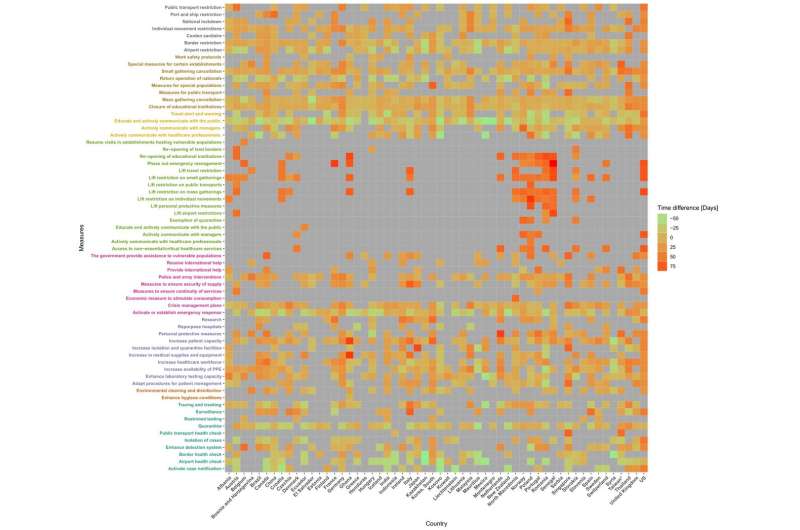Detailed dataset of measures to curb COVID-19 ready for statistical analyses

To know which non-pharmaceutical interventions against the spread of coronavirus worked best, researchers and health authorities need data. In March, the Complexity Science Hub Vienna (CSH) started a comprehensive worldwide collection of governmental measures, which is now published in the Nature journal Scientific Data.
The CSH COVID-19 Control Strategies List (CCCSL) to date includes information on 6,068 interventions from 56 countries: 33 European, 12 Asian, five South American, two North American, three African, and one Oceanian countries, plus the cruise ship Diamond Princess. For the U.S., data were collected at the state level for 24 US states.
Highly detailed data for in-depth analyses
"The special value of our dataset is its granularity," says project leader and first author Amelie Desvars-Larrive (CSH and Univ of Veterinary Medicine Vienna). "To our knowledge, it is to date the most detailed classification of government measures against COVID-19."
On the most general level (L1), the scientists divided the measures in seven groups: case identification; contact tracing and related measures; environmental measures, such as disinfection and cleaning of common surfaces (public transports, markets); healthcare and public health capacity (e.g. increase of the hospital capacity or of the healthcare workforce); resource allocation (like operations involved in the allocation of budgets, deployment of resources, and distribution of goods for controlling a disease outbreak); risk communication; social distancing; travel restriction; and, a newer category, returning to normal life.
Each intervention is coded into four levels, from a broad categorisation of the measures (L1) to a very specific description (L4). "As an example, we have seven categories of travel restrictions, which are further divided into more than 50 subcategories," says Desvars-Larrive. Moreover, the use of self-explanatory codes makes the dataset readily comprehensible, even for non-experts.
The coding scheme of the dataset exhibits a great analytical flexibility and makes it especially valuable for computer-aided techniques like machine learning.
Dealing with a pandemic
"With the CCCSL, we hope to contribute to a better management of the corona crisis or similar epidemics in the future," says David Garcia (CSH & Medical Univ of Vienna), one of the co-authors. "With comprehensive data, scientists and politicians will be able to better assess individual risks, to develop tailor-made containment strategies or approaches how to end strict measures, for instance."
For example, scientists at the CSH were combining the CCCSL data with publicly available data on COVID-19 cases. "We quantified the impact of individual control policies and came up with a ranking according to their effectiveness in reducing coronavirus spread," explains Amelie Desvars-Larrive. These findings are currently under review.
The data were collected from public sources, including official government sources, scientific papers, press releases, government communications and social media. All records were hand-coded and are updated on a regular basis.
During the COVID-19 crisis, other research teams have concomitantly tracked data on government policies. Joining forces to fight the pandemic, the CCCSL and six other international datasets have been integrated into the global dataset Tracking Public Health and Social Measures (PHSM) aggregated by the World Health Organization.
More information: Amélie Desvars-Larrive et al, A structured open dataset of government interventions in response to COVID-19, Scientific Data (2020). DOI: 10.1038/s41597-020-00609-9















